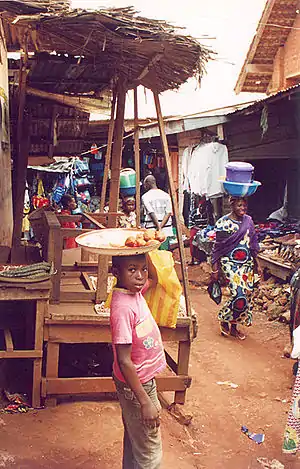Abong-Mbang | |
|---|---|
 Abong-Mbang, Cameroon, looking north from Quartier Haussa toward the Nyong River | |
 Abong-Mbang Map of Cameroon showing the location of Abong-Mbang | |
| Coordinates: 3°59′N 13°10′E / 3.983°N 13.167°E | |
| Country | |
| Province | East |
| Division | Haut-Nyong |
| Sub-division | Abong-Mbang |
| Government | |
| • Mayor | Gustave Mouamossé |
| Population (2001) | |
| • Urban | 18,700 |
| estimated | |
| Time zone | UTC+1 (WAT) |
| Climate | Aw |
Abong-Mbang is a town and commune in the East Region of Cameroon. Abong-Mbang is located at a crossroads of National Route 10 and the road that leads south to Lomié. Yaoundé, the capital of Cameroon, is 178 km to the west, and Bertoua, the capital of the East Province, lies 108 km to the east. From Ayos, at the border in the Centre Province 145 km (90 mi) from Abong-Mbang, the tar on National Route 10 ends and a dirt road begins.[1] Abong-Mbang is the seat of the Abong-Mbang sub-division and the Haut-Nyong division. The town is headed by a mayor.[2] Gustave Mouamossé has held the post since August 2002.[3] Abong-Mbang is site of one of the East Province's four Courts of First Instance[4] and a prefectural prison.[5] The population was estimated at 18,700 in 2001.[6]
History
According to oral traditions of the Kwassio and Bakola peoples, Abong-Mbang was settled when the Maka-Njem peoples moved northwest from the Great Lakes region of the Congo River. They encountered Pygmy hunter-gatherers and requested their aid as guides through the region. Some of the migrants settled in the vicinity, which they called Bung-Ngwang ("bathing area in the Nyong River"). When Europeans arrived in the 19th century, this name was changed to Abong-Mbang. Some migrants continued westward in search of salt; they became the Kwassio and Bakola of Cameroon's coast.[7] German colonisers moved into the area in the late 19th century. They used the Nyong River as a means to reach the wild rubber growing farther inland.[8] The Germans built a fort and other military and administrative buildings in the town. The fort is today a prefectural prison, and the other buildings serve similar administrative functions.[9][10] The French took over in 1919 following Germany's defeat in World War I.

People and economy
Abong-Mbang is the main settlement of the Maka people, a group who speak a Bantu language of the same name.[11] Much of the population farms; important crops include bananas, cocoa, corn, groundnuts, tomatoes, and tubers. Shifting cultivation with no fertiliser is the primary method of agriculture.[12] Baka hunter-gatherers live in the surrounding forests. Since colonial times, the government has attempted to better integrate this group into Cameroonian society.[13] Abong-Mbang is part of the Doumé-Abong-Mbang diocese of the Roman Catholic Church. The church estimates that 46.7% of the population is Roman Catholic.[14]
Since Francophone Cameroun's independence in 1960, Abong-Mbang has become an important centre of commerce for the East Province.[15] This has led to a cosmopolitan influx of immigrants from outside the Maka area. An estimated 99% of males and 95% of females speak French.[16] However, among traders, Ewondo is the lingua franca of choice: 72% use Ewondo but only 48% use French in market situations.[17] By the late 1970s, the government had zoned large areas of the surrounding forest for timber exploitation.[18] Most timber and bushmeat traffic from the East Province passes through the town.[19] Union Abong-Mbang FC is the local football (soccer) team.[20] The town often suffers prolonged cuts to electric power, which the utility company, AES-SONEL, blames on an aging power plant. On 17 September 2007, violent protests against the cuts ended with two protesters dead and 10 others seriously injured.[21]

Geography
Abong-Mbang lies on the South Cameroon Plateau, approximately 700 metres above sea level.[22] The soils are red.[19] The Boumba, Dja, and Nyong rivers rise in the Abong-Mbang region. The Nyong forms the town's northern border and is navigable for about 160 km (100 mi) to Mbalmayo in the Centre Province.[8] The area along the Nyong consists of swampy forests that support populations of raffia palm, such as Raphia montbuttorum.[12][23] The area surrounding the town consists of secondary-growth forest of semi-deciduous trees, particularly Sterculiaceae and Ulmaceae; the primary-growth forest has been removed for logging and farming. In some areas, the forests are further degraded and home to other forms of vegetation. The Abong-Mbang Forest Reserve is north of the town. Local wildlife includes populations of western lowland gorilla[24][25] and forest elephants. An estimated 100 elephants lived in the Abong-Mbang Forest Reserve in 1998.[26] The Ntimbe Caves are 18 km (11 mi) south of the town.[10]
Notes
- ↑ Hudgens and Trillo 1115.
- ↑ Mahop.
- ↑ Elvido.
- ↑ Geschiere, Witchcraft, 262 note 4.
- ↑ Chrispin 52.
- ↑ Institut National de la Statistique 41.
- ↑ Ngima Mawoung 213.
- 1 2 Quinn 15.
- ↑ Chrispin 52–53.
- 1 2 West 191.
- ↑ Fisiy and Geschiere 230.
- 1 2 Boeglin et al. 277.
- ↑ Oyono 119.
- ↑ Cheney.
- ↑ Peterson 106.
- ↑ Sio Bobda.
- ↑ Wolf 167.
- ↑ Wolfheim 688.
- 1 2 Rose 2.
- ↑ Foimoukom.
- ↑ Nsom.
- ↑ Sigha-Nkamdjou et al. 216.
- ↑ Stuart 58.
- ↑ Albrecht et al. 71.
- ↑ Redmond 305.
- ↑ Barnes et al. 41.
References
- Albrecht, Gene H., Bruce R. Gelvin, and Joseph M. A. Miller (2003). "The hierarchy of intraspecific craniometric variation in gorillas: A population-thinking approach with implications for fossil species recognition studies", Gorilla Biology: A Multidisciplinary Perspective. Cambridge University Press. ISBN 0-521-79281-9.
- Barnes, R. F. W., G. C. Craig, H. T. Dublin, G. Overton, W. Simons, and C. R. Thouless (1999). African Elephant Database 1998. Cambridge: IUCN Publications Services Unit. ISBN 2-8317-0492-8.
- Boeglin, Jean-Loup, Jean-Luc Probst, Jules-Rémy Ndam-Ngoupayou, Brunot Nyeck, Henri Etcheber, Jefferson Mortatti, and Jean-Jacques Braun (2006). "Soil Carbon Stock and River Carbon Fluxes in Humid Tropical Environments: The Nyong River Basin (South Cameroon)", Soil Erosion and Carbon Dynamics. Boca Raton, Florida: Taylor & Francis Group. ISBN 1-56670-688-2.
- "Chapitre 4: Caracteristiques de la Population", Deuxième Partie: Population et Affaire Sociale, Annuaire Statistique du Cameroun 2006.
- Cheney, David M. (7 January 2007). "Diocese of Doumé-Abong' Mbang". The Hierarchy of the Catholic Church. Accessed 24 May 2007.
- Chrispin, Pettang, directeur, Cameroun: Guide touristique. Paris: Les Éditions Wala.
- Elvido, Sebastian Chi (2 August 2007). "Abong-Mbang : Les élites montent les populations contre le maire". Mutations Quotidien. Accessed 4 August 2007.
- Fisiy, Cyprian F., and Peter Geschiere (2001). "Witchcraft, development and paranoia in Cameroon: interactions between popular, academic and state discourse". Magical Interpretations: Material Realities: Modernity, Witchcraft and the Occult in Postcolonial Africa. Routledge.
- Foimoukom, Honoré (22 November 2005). "Inter-poules 2005: la dernière ligne droite: Le calendrer complet (voir encadré de la compétition est connu." Le Messager. Accessed 21 May 2007.
- Geschiere, Peter (1997). The Modernity of Witchcraft: Politics and the Occult in Postcolonial Africa. Charlottesville: University Press of Virginia.
- Hudgens, Jim, and Richard Trillo (1999). West Africa: The Rough Guide. 3rd ed. London: Rough Guides Ltd.
- Mahop, Charles (4 October 2006). "Abong-Mbang: Chasse aux vêtements provocants". Quotidien Mutations. Accessed 23 May 2007.
- Ngima Mawoung, Godefroy (March 2001). "The Relationship between the Bakola and the Bantu Peoples of the Coastal Regions of Cameroon and Their Perception of Commercial Forest Exploitation". African Study Monographs, Suppl. 26: 209—235.
- Oyono, Phil René (2004). "From Diversity to Exclusion for Forest Minorities in Cameroon". The Equitable Forest: Diversity, Community, & Resource Management. Resources for the Future. ISBN 0-915707-96-9.
- Nsom, Kini (20 September 2007). "Sequel To AES SONEL Crisis:Gov't Says SDO Did Not Kill Students". ThePostNewsLine.com. Accessed 26 September 2007.
- Peterson, Dale (2003). Eating Apes. Berkeley: University of California Press. ISBN 0-520-23090-6.
- Quinn, Frederick (2006). In Search of Salt: Changes in Beti (Cameroon) Society, 1800–1960. Berghahn Books. ISBN 1-84545-006-X.
- Redmond, Ian (2005). "Where Are the Great Apes and Whose Job Is It to Save Them?" World Atlas of Great Apes and Their Conservation. Berkeley: University of California Press.ISBN 0520246330.
- Rose, Anthony L. (1998). "On the Road with a Gorilla Hunter: Turning Poachers to Protectors". Hermosa Beach, California: Wildlife Protectors Fund/Gorilla Foundation.
- Sigha-Nkamdjou, Luc, Daniel Sighomnou, Gaston Lienou, Gaspard Ayissi, J. Pierre Bedimo, and Emmanuel Noah (1998). "Variabilité des régimes hydrologiques des cours d'eau de la band méridionale du plateau sud-camerouais", Water Resource Variability in Africa during the XXth Century: (Variabilité des Ressources en Eau en Afrique au XXème Siècle). International Association of Hydrological Sciences Press. ISBN 1-901502-65-1.
- Simo Bobda, Augustin (16 December 2001). "Varying perception of English in Cameroon: A diachronic and synchronic analysis". TRANS. Internet-Zeitschrift für Kulturwissenschaften, No. 11. Accessed 23 May 2007.
- Stuart, Simon N. (1990). Biodiversity in Sub-Saharan Africa and its Islands: Conservation, Management and Sustainable Use. Occasional Papers of the IUCN Species Survival Commission, No. 6. The World Conservation Union (IUCN). ISBN 2-8317-0021-3.
- West, Ben (2004). Cameroon: The Bradt Travel Guide. Guilford, Connecticut: The Globe Pequot Press Inc.
- Wolf, Hans-Georg (2001). English in Cameroon. Mouton de Gruyter. ISBN 3-11-017053-1.
- Wolfheim, Jaclyn H. (1983). Primates of the World: Distribution, Abundance, and Conservation. Routledge. ISBN 3-7186-0190-7.
